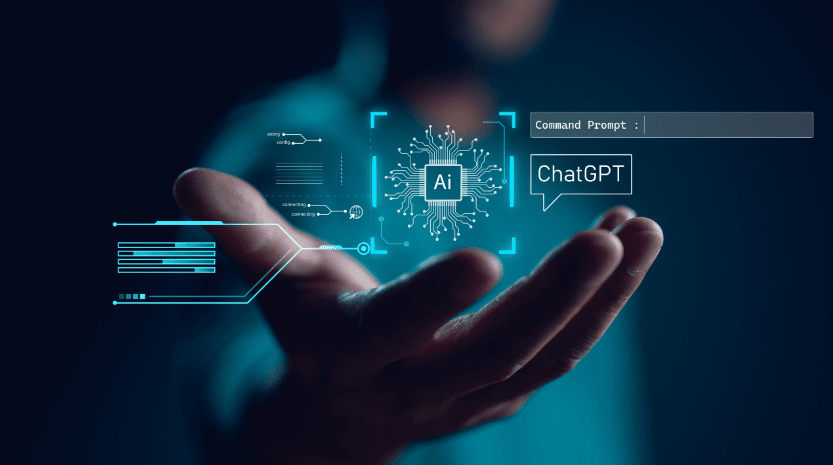An Exploration of the Impact of AI Applications in Business

Artificial intelligence is a hot topic at the moment. From the widespread adoption of solutions, such as ChatGPT to its integration within technology and communication solutions for smarter operations, businesses all over the world are taking advantage of the benefits AI. According to a report by Capital Economics for the Department for Digital, Culture, Media & Sport (DCMS), 15% of all businesses in the UK have adopted at least one form of AI technology. This adoption is only going to grow with 22.7% of companies expected to be using AI by 2025 and a 33.3% of businesses expected to have at least one AI tool by 2040, according to this Capital Economics’ research.
Despite the adoption rates of AI and the benefits it has proven to provide for businesses, there is still some fear and scepticism surrounding this technology. From worries that this technology will remove certain jobs from human employees to fears about security and privacy risks that AI could pose, there are a few challenges that could prevent some businesses from adopting this technology.
There is no doubt that AI is not only here to stay, it is going to play a big role in the future of business, so it’s important to understand how this technology works and the benefits, as well as risks this technology could pose. Which is exactly what we’re going to do in this article. We’re going to take a look at the opportunities and challenges presented by AI in business.
How Does Artificial Intelligence Work?
When we think of artificial intelligence, we think of human-like robots, talking and thinking for themselves – akin to something from a science-fiction movie. Although it can and has been used for creating human-like robots, it has a vast range of other practical uses, including a range of features that can optimise business operations to make them more efficient and create unique customer experiences. Before we explore what this technology can do, let’s explore how it works.
In simple terms, AI is the science that enables machines to simulate human intelligence processes. Training an AI model is similar to training the human brain – it has to learn. This is achieved through training AI algorithms using large amounts of data, so it learns to identify patterns, make predictions and recommend actions. The more information it processes, the better actions and decisions it can produce on its own and it finds it easier to navigate unfamiliar situations with the knowledge it has learned.
The Opportunities: How is AI Being Used in Business?
Artificial intelligence is already transforming businesses across industries – you will have likely used it yourself either within business or when using applications such as social media or search engines. Whether you’ve utilised AI intentionally or otherwise, it’s impact cannot be denied and its presenting a wide range of opportunities and benefits for businesses globally. Let’s take a look at some examples of artificial intelligence in business.
AI in Retail – Starbucks

Coffeehouse giant, Starbucks, have harnessed the power of AI to improve their customer’s ordering process. Over the years, Starbucks have transformed the idea of a picking up a coffee from being a simple transaction to an experience. They have demonstrated their commitment to providing the best customer service through:
- Barista training going beyond drink-making to incorporate how to connect with customers.
- Providing a personalised service to every customer, from their wide choices of milks, right down to serving each customer by name.
- Investing in their employee experience, through offering benefits and nurturing a caring workplace.
- Embracing technology to streamline their service further and provide new experiences for their customers.
It’s this commitment that has enabled their business to grow to the gargantuan size we know today with almost 36,000 stores worldwide.
Always one step ahead of the game, they introduced My Starbucks Barista, way back in 2017, which allows customers to chat with an AI-powered virtual assistant to place their order via voice or text. The customer can then arrive at their local Starbucks and pick up their order that’s ready and waiting for them, removing the need to stand in a line. Further to this, Starbucks launched their AI and ML (machine learning) platform, Deep Brew, in 2019 to help create customer experiences that are even more personalised, optimise store allocation and manage inventory. So far, Deep Brew has enhanced drive-through experiences and automated time-consuming tasks, such as inventory management and preventative maintenance on their IoT connected espresso machines.
Now, it may look like Starbuck’s are trying to reduce the human connection within their business, through the utilisation of AI, which would go against their entire business model of providing a personalised service and creating a friendly atmosphere with positive interactions. This isn’t the aim of their Deep Brew platform. Deep Brew has been designed to be more like a super assistant for Starbuck’s human baristas through:
- Automating time-consuming tasks, such as inventory management
- Organising orders for stock replenishment
- Anticipating staffing needs and creating schedules
- Predictive maintenance though notifying staff when a coffee machine needs attention
This saves employees valuable time, which can be invested back into providing valuable customer experiences.
The use of AI in business can provide an advantage where business continuity is concerned. Deep Brew was instrumental during the Covid-19 pandemic, when service was reduced to drive-through only. Starbuck’s locations could leverage data, such as time of day, amount of traffic, day of the week and the individual store’s ‘personality’ with AI to customise the recommendations that appear at the drive-throughs – encouraging people to return to the business, despite mandatory restrictions prohibiting their normal levels of service.
AI in Travel – Hilton

Remember those robots we mentioned earlier? Well, the hotel-chain, Hilton, is a fine example of how businesses are utilising AI and advanced robotic technology to create innovative additions to their service. In 2016, Hilton introduced their robot concierge, Connie, to answer queries from guests relating to hotel features and local attractions, as well as offering recommendations for their stay. Connie was created in collaboration with technology giant, IBM and utilisies domain knowledge from their flagship AI programme, Watson and AI specialists WayBlazer. She uses Natural Language Processing to understand the sentences when a guest talks to her and relies up on the knowledge gained from IBM and WayBlazer’s data to create an answer. Connie continuously learns from human interactions and improves its capabilities. Standing at two and a half feet tall, this AI-powered, pint-sized assistant is capable of moving its arms and legs to point guests in the right direction and its eyes light up in different colours to convey a spectrum of human emotions.
Similar to Starbucks and replacing human resource for menial tasks with AI to free up time, Hilton created Connie to prioritise time for human resource, rather than replacing it all together. Connie is capable of taking care of common questions, which allows human staff to have more time to focus on more complex customer problems, queries and requests. Connie was a pilot project to see the impact of robotics and AI within Hilton’s business model and it was a success, so does this mean that Hilton is likely to implement teams of C3-PO-esque robots within their hotels? No, they’ve made it clear that human interaction is irreplaceable and if Connie is to be used throughout their locations, she will be viewed as an assistant to their human staff.
AI in Communications

Another key example of a practical application of AI is within communications. AI provides the ability to automate calls that entail simple requests or queries, to free up agents’ time and also offer intelligent call queuing which allows customers to self-serve, further streamlining communication channels. This optimisation of business communication improves customer experiences, through reducing frustration and allowing quicker access to human agents for customers who really need them and providing quick answers via automation for customers with simple requests.
Cost-effectiveness is another huge benefit that AI presents for business communications. With time being saved through agents’ time being prioritised for more complex problems, more resource is available without having to pay for more physical people servicing customers. Let’s explore an example – we’ll look at a fictional company, but the facts and figures are based off a few real scenarios where we’ve saved our customers time and money with AI.
Example: Flip Flop Travel Company
Flip Flop Travel Company are an online travel agents that have been steadily growing over the last few years. Although their business operates online, they have a customer service team based within a contact centre who handle customer queries, issues and complaints. As their business grew, their team were having to handle an increasing amount of customer interactions, which resulted in increased wait times for customers. They worked with us to implement a CCaaS solution (Contact Centre as a Service) that integrated AI within the platform. This allowed Flip Flop Travel Company to deflect or automate a portion of their calls using artificial intelligence. This directed simple customer interactions towards self-service and automated options and freed up Agents’ time for more complex queries that require a human touch.
Let’s take a look at the numbers. In one month, Flip Flop portioned 1160 calls to the integrated AI solution via their IVR within their CCaaS solution. With calls lasting around 8 minutes each, this equated to 9,280 minutes (around 154.6 hours) of agents’ time that was saved, over the course of a month. Using the National Living Wage as a benchmark (£10.42 an hour and around £19,256.20 per year) this equates to a cost saving of £1611.10 per month and £19,339 a year! With the implementation of a CCaaS solution with AI, Flip Flop Travel Company were able to service more calls with the same resource – now that’s intelligent!
AI in Healthcare – NHS

The capabilities of AI is also proving useful for the healthcare industry, with a range of capabilities utilising the technology. One key example is the use of AI within mammograms to support radiologist assessments during breast cancer screening. Kheiron Medical Technologies leveraged deep learning artificial intelligence within breast cancer screening to create Mia™ (mammography intelligent assessment) to analyse standard mammograms for breast cancer screening. This solution is the first product, developed by a UK company, to receive the CE mark for deep learning software in radiology.
In the NHS (and most of Europe), every mammogram is double-checked by radiologists, with the second opinion, typically, being blind to the first. Although this process is necessarily thorough, it is labour-intensive and time-consuming, which leads to delays for people relying on the results of these scans, due to staff shortages within the system. Of course, these delays can have catastrophic consequences for those waiting for results and even those who are waiting for a scan appointment in the first place.
Mia™ was designed to be the second reader within the workflow, combining the efficiency of artificial intelligence, whilst retaining the human element within the process. Should Mia™ and the human reader disagree, a second human radiologist is brought in to make the final call, so patients can be rest assured that human radiologists always have authority over the AI. This combination of human and AI resource, frees up the time of clinicians that can be used to spend time with patients, reduces the pressure to find new radiologists and has the potential to enable greater number of patients to be screened more quickly. Developing Mia™ involved using convoluted neural networks, which is a form of deep learning that is trained using over 3 million images. This solution earned Kheiron Medical Technologies phase 4 funding via the AI Health and Care awards, which will be used to develop multiple deployments and run clinical studies across 15 hospital sites across the UK to ensure it is safe, effective and will benefit both breast screening units and the patients who attend them.
These are just three examples of practical uses for AI that organisations are already implementing, but it demonstrates the key opportunities that this technology provides:
- Automating menial tasks
- Allowing time to be reinvested in tasks that provide more value
- Enhanced user and customer experiences
- Fast data processing for quick decision-making
Key Challenges Presented by AI in Business

So, we’ve explored a few key examples of AI benefits that businesses across all industries can take advantage of, but it’s naïve to present these benefits without highlighting the challenges that can be posed by this sophisticated technology. From data security to the complexity of this technology and skill gaps, there are a few key challenges that businesses would have to consider before adopting this technology within their operations. Let’s take a look at a couple of examples:
Data Privacy and Ethics Concerns
As we’ve already established, AI requires large amounts of data in order to ‘learn’, the big question is – where is this data coming from? When it comes to using AI to enhance customer experiences, customer information will have to be collected and analysed in order for the AI to make informed decisions. This raises concerns from customers regarding data privacy and ethical use of their data. However, businesses need to adhere to regulations relating to data privacy and ethics surrounding the use of personal data, such as GDPR. Failure to comply with these regulations will result in a business facing hefty fines and even criminal lawsuits. Although this provides some peace of mind for their customers, as their data will be protected from malpractices, this poses a challenge for businesses looking to use customer data within AI solutions. Businesses will need to figure out a way to strike a balance between utilising personal data to improve their business and safeguarding user privacy, as well as ensuring that their AI solutions comply with relevant data protection laws and regulations. As we’ve seen with our success stories in the previous section – it is possible and the rewards for businesses who successfully strike this balance have the potential to skyrocket a business.
Furthermore, AI can also raise ethical challenges when it comes to decisions or information produced as a result of historical data that may contain outdated biases, opinions or perceptions. As we’ve said, AI requires huge amounts of data in order to ‘learn’ effectively, which means the likelihood of it consuming information that contains harmful, outdated and discriminative information is quite high. If this harmful information isn’t identified, AI can, unintentionally perpetuate discrimination or inequalities. However, this is a challenge that would require continuous monitoring, transparency and refining algorithms to eliminate biases or harmful information.
Skill Gaps
The adoption of AI in business can lead to concerns amongst team members that their job will be replaced by this technology. Again, as we saw with Hilton and Starbucks, AI is predominantly being used in addition to human power to streamline workflows and automate menial tasks to make time for valuable activity. However, this fear isn’t completely unfounded. It is possible that this technology will take over some routine jobs, where it will serve a company more efficiently than human team members. Furthermore, utilising this technology will involve human workers building upon existing skills in order to work with AI systems and solutions.
Again, businesses will need to find a balance between phasing out jobs that have become obsolete thanks to AI adoption and retaining human talent that can be transitioned into roles that require more complex and creative thinking. As this technology will need to work in tandem or be overseen by a human worker, it’s wise for businesses to invest in retraining and reskilling as part of their AI adoption strategy. Although AI does have the potential to automate routine tasks and will increasingly be able to handle more and more complex tasks that previously have been the sole responsibility of human talent – we’ve seen that it’s best used in collaboration with human interaction, as opposed to replacing humans in the workplace.
Lack of Understanding and Knowledge
Although AI is a technology that has been around now for a number of years, many people (including key decision makers and team members) will be clued up on how this technology works, it’s potential and its limitations. This lack of knowledge will result in businesses underutilising AI or having unrealistic expectations for its capabilities. A lack of skill when it comes to operating AI solutions, can also mean that their not used effectively, resulting businesses underestimating their capabilities as a result of user error rather than the solutions not delivering as expected.
Let’s take ChatGPT as an example. It’s seen a widespread adoption amongst both businesses and individuals and, when used correctly, it’s a powerful solution that can be used in a variety of settings. However, AI solutions are programmes at the end of the day, and programmes still require human skill to monitor, manage and use them effectively. Although ChatGPT does have it’s limitations (as all AI solutions do), many failed attempts to gain the information needed from this tool is down to user error and not knowing the precise command for said information, rather than the limitations of the solution itself. In order to integrate AI effectively within a business, the knowledge and skills of decision-makers and users, alike, will be a continuous challenge that will need to be mediated with relevant training and education.
Overcoming these challenges is possible – businesses and organisations are successfully managing to do so. However, it requires a holistic approach to AI adoption in business, that combines technical expertise, ethical considerations, strategic planning and ongoing learning and adaptation.
The Importance of Digital Transformation with AI

Investing in AI solutions requires effective digital transformation of a business. Relying on out of date solutions, means that you won’t see the return on your investment and will not be able to take advantage of everything AI has to offer. Furthermore, investing in digital solutions will allow you to incorporate AI within those solutions to boost their capabilities. For example, swapping out your legacy communications system for a digital, feature-rich CCaaS solution will allow access to a range of features designed to enhance customer experiences, beyond the capabilities of your previous system. CCaaS solutions allow the integration of AI for smarter workflows, intelligent call handling and self-service options for your customers. AI will not be compatible, with out-of-date, analogue systems or legacy software, so it’s important to factor in the cost of digital solutions when considering the adoption of AI. Working with a knowledgeable provider is key to ensure that you invest in the right digital and AI solutions for your business, to avoid wasting time and money.
Optimise Your Business for AI with Netcentrix
Whether you’re looking to adopt AI within your communications or are looking for ways to streamline workflows through automation or bolstering security with artificial intelligence – we can help! Let us help you to transform your business with our suite of up-to-date, digital solutions and accompanying services that are ready for AI integration. Talk to one of our specialists today by filling in our contact form or calling 0344 875 8880.


















